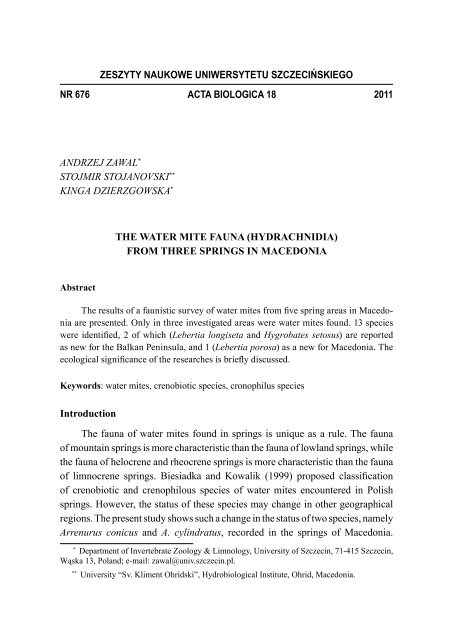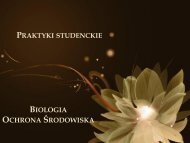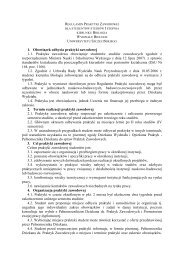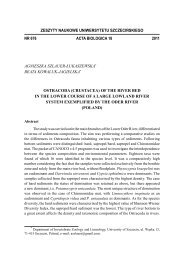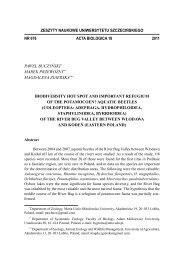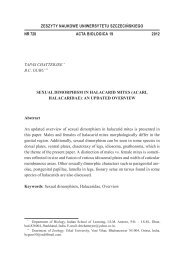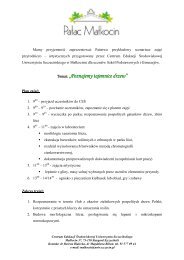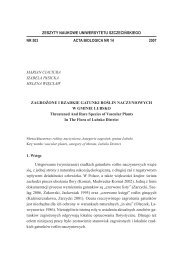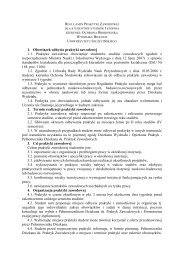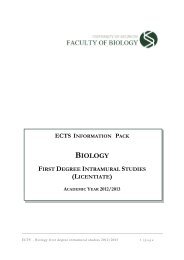7 The water mite fauna (Hydrachnidia) from three springs in ...
7 The water mite fauna (Hydrachnidia) from three springs in ...
7 The water mite fauna (Hydrachnidia) from three springs in ...
Create successful ePaper yourself
Turn your PDF publications into a flip-book with our unique Google optimized e-Paper software.
ZESZYTY NAUKOWE UNIWERSYTETU SZCZECIŃSKIEGO<br />
NR 676 ACTA BIOLOGICA 18<br />
2011<br />
ANDRZEJ ZAWAL * 1<br />
STOJMIR STOJANOVSKI ** 2<br />
KINGA DZIERZGOWSKA *<br />
THE WATER MITE FAUNA (HYDRACHNIDIA)<br />
FROM THREE SPRINGS IN MACEDONIA<br />
Abstract<br />
<strong>The</strong> results of a faunistic survey of <strong>water</strong> <strong>mite</strong>s <strong>from</strong> five spr<strong>in</strong>g areas <strong>in</strong> Macedonia<br />
are presented. Only <strong>in</strong> <strong>three</strong> <strong>in</strong>vestigated areas were <strong>water</strong> <strong>mite</strong>s found. 13 species<br />
were identified, 2 of which (Lebertia longiseta and Hygrobates setosus) are reported<br />
as new for the Balkan Pen<strong>in</strong>sula, and 1 (Lebertia porosa) as a new for Macedonia. <strong>The</strong><br />
ecological significance of the researches is briefly discussed.<br />
Keywords: <strong>water</strong> <strong>mite</strong>s, crenobiotic species, cronophilus species<br />
Introduction<br />
<strong>The</strong> <strong>fauna</strong> of <strong>water</strong> <strong>mite</strong>s found <strong>in</strong> <strong>spr<strong>in</strong>gs</strong> is unique as a rule. <strong>The</strong> <strong>fauna</strong><br />
of mounta<strong>in</strong> <strong>spr<strong>in</strong>gs</strong> is more characteristic than the <strong>fauna</strong> of lowland <strong>spr<strong>in</strong>gs</strong>, while<br />
the <strong>fauna</strong> of helocrene and rheocrene <strong>spr<strong>in</strong>gs</strong> is more characteristic than the <strong>fauna</strong><br />
of limnocrene <strong>spr<strong>in</strong>gs</strong>. Biesiadka and Kowalik (1999) proposed classification<br />
of crenobiotic and crenophilous species of <strong>water</strong> <strong>mite</strong>s encountered <strong>in</strong> Polish<br />
<strong>spr<strong>in</strong>gs</strong>. However, the status of these species may change <strong>in</strong> other geographical<br />
regions. <strong>The</strong> present study shows such a change <strong>in</strong> the status of two species, namely<br />
Arrenurus conicus and A. cyl<strong>in</strong>dratus, recorded <strong>in</strong> the <strong>spr<strong>in</strong>gs</strong> of Macedonia.<br />
1*<br />
Department of Invertebrate Zoology & Limnology, University of Szczec<strong>in</strong>, 71-415 Szczec<strong>in</strong>,<br />
Wąska 13, Poland; e-mail: zawal@univ.szczec<strong>in</strong>.pl.<br />
2**<br />
University “Sv. Kliment Ohridski”, Hydrobiological Institute, Ohrid, Macedonia.
120 Andrzej Zawal, Stojmir Stojanovski, K<strong>in</strong>ga Dzierzgowska<br />
It focuses on the characteristics of <strong>water</strong> <strong>mite</strong>s encountered <strong>in</strong> <strong>three</strong> Macedonian<br />
<strong>spr<strong>in</strong>gs</strong> which has never been previously <strong>in</strong>vestigated with regard to <strong>water</strong> <strong>mite</strong>s.<br />
However there are some other dates <strong>from</strong> the <strong>spr<strong>in</strong>gs</strong> (Kunz 2006, Subaquatic<br />
Spr<strong>in</strong>gs 2005–2008) <strong>The</strong> study has lead to a discovery of two new species for the<br />
Balkan Pen<strong>in</strong>sula, namely Lebertia longiseta and Hygrobates setosus, and one<br />
new species for Macedonia, namely Lebertia longiseta.<br />
Material and methods<br />
<strong>The</strong> <strong>in</strong>vestigation of <strong>water</strong> <strong>mite</strong>s <strong>from</strong> <strong>spr<strong>in</strong>gs</strong> <strong>in</strong> Macedonia was carried out<br />
on 20–22 February and 19–30 June 2009. In shallow places (< 1 m) <strong>water</strong> <strong>mite</strong>s<br />
were caught us<strong>in</strong>g a hydro-biological sampler with a triangular hoop, with the<br />
length of the side equall<strong>in</strong>g 20 cm. Each time 20 sweeps were performed, each<br />
cover<strong>in</strong>g about 1 m, which allowed the area of ca. 0.2 m 2 <strong>in</strong> total to be covered.<br />
Water <strong>mite</strong>s were identify by keys: Viets (1936), Sokolov (1940), Wa<strong>in</strong>sta<strong>in</strong><br />
(1980), Zawal (2008) and Di Sabat<strong>in</strong>o et. al. (2010).<br />
Five spr<strong>in</strong>g system areas was <strong>in</strong>vestigated, but <strong>in</strong> two of them there was<br />
no <strong>water</strong> <strong>mite</strong>s. <strong>The</strong> material was collected <strong>in</strong> <strong>three</strong> spr<strong>in</strong>g systems compris<strong>in</strong>g:<br />
1) <strong>spr<strong>in</strong>gs</strong> <strong>in</strong> St. Naum; 2) Biljan<strong>in</strong>i <strong>spr<strong>in</strong>gs</strong> near the Hydrobiological Institute<br />
<strong>in</strong> Ohrid; 3) “Podgoricko Ezero”. In the first of systems 12 samples were collected<br />
<strong>in</strong> 7 localities (5 <strong>in</strong> February and 7 <strong>in</strong> June), but <strong>water</strong> <strong>mite</strong>s were encountered<br />
only <strong>in</strong> 5 localities. In the second system 3 samples <strong>in</strong> 3 localities (1 <strong>in</strong> February<br />
and 2 <strong>in</strong> June) were collected. In the third system 8 samples <strong>in</strong> 8 localities<br />
(<strong>in</strong> June), were collected but <strong>water</strong> <strong>mite</strong>s were present only <strong>in</strong> 5 samples.<br />
<strong>The</strong> collected material conta<strong>in</strong>ed adult specimens as well as larvae (Table<br />
1). While analys<strong>in</strong>g the abundance and frequency of occurrence, only adult<br />
stages were taken <strong>in</strong>to account, s<strong>in</strong>ce the larvae were encountered <strong>in</strong> clusters and<br />
each egg cluster was probably laid by an <strong>in</strong>dividual female. Tak<strong>in</strong>g the larvae <strong>in</strong>to<br />
account would artificially <strong>in</strong>crease the abundance of some species.
<strong>The</strong> <strong>water</strong> <strong>mite</strong> <strong>fauna</strong> (<strong>Hydrachnidia</strong>) <strong>from</strong> <strong>three</strong> <strong>spr<strong>in</strong>gs</strong> <strong>in</strong> Macedonia<br />
121<br />
Table 1. Water <strong>mite</strong>s (<strong>Hydrachnidia</strong>) <strong>from</strong> <strong>spr<strong>in</strong>gs</strong> <strong>in</strong> Macedonia<br />
No. Species ♀♀ ♂♂ larvae total<br />
adult<br />
abundance %<br />
frequency %<br />
St. Naum<br />
Biljan<strong>in</strong>i<br />
Podgoricko<br />
Ezero<br />
n.s. % n.s. % n.s. %<br />
1 Lebertia <strong>in</strong>aequalis<br />
(Koch) 8 7 10 25 6.5 30.8 14 9.5 1 2.6<br />
2 L. porosa (Thor) 2 2 0.9 7.7 2 1.4<br />
3 L. longiseta (Bader) 1 1 0.4 7.7 1 0.7<br />
4 L. schechteli (Thor) 1 1 0.4 7.7 1 2.6<br />
5 Oxus strigatus<br />
(Müller) 1 3 10 14 1.7 7.7 4 2.7<br />
6 Hygrobates fl uviatilis<br />
(Strom) 95 48 45 188 61.6 46.2 96 65.3 47 100<br />
7 H. longipalpis<br />
(Herm.) 9 148 157 3.9 38.5 9 6.1<br />
8 H. setosus (Bess.) 11 28 39 4.7 38.5 10 6.8 1 2.6<br />
9 Forelia variegator<br />
(Koch) 1 1 0.4 7.7 1 0.7<br />
10 Piona conglobata<br />
(Koch) 9 61 70 3.9 23.1 9 23.7<br />
11 P. pusilla (Neum.) 12 2 59 73 6.0 30.8 14 36.8<br />
12 Arrenurus conicus<br />
(Piers) 12 4 67 83 6.9 23.1 4 2.7 12 31.6<br />
13 A. cyl<strong>in</strong>dratus<br />
(Piers.) 6 3 9 2.6 15.4 6 4.1<br />
Total 167 65 431 663 147 47 38<br />
Description of the area<br />
<strong>The</strong> “S<strong>in</strong>i Virovi” spr<strong>in</strong>g system area, near village Belcista, about 30 km<br />
<strong>from</strong> Ohrid constitute a system rheocrenes and helocrens on the border of valley<br />
which flow-off <strong>in</strong>to the floor of the valley. <strong>The</strong> valley is cover by meadows and<br />
pastures. <strong>The</strong> samples were collected <strong>from</strong> two limnocrenes, one rheocrenes and<br />
one helocrenes situated on pasture. <strong>The</strong>re was no <strong>water</strong> <strong>mite</strong>s.<br />
<strong>The</strong> “Mera” spr<strong>in</strong>g system area, near village Izdeglavie, about 35 km <strong>from</strong><br />
Ohrid. <strong>The</strong> valley covered by meadow and pasture with some limnocrenes and<br />
helocrenes. <strong>The</strong> samples were collected <strong>from</strong> one limnocren and one helocren.<br />
<strong>The</strong>re was no <strong>water</strong> <strong>mite</strong>s.
122 Andrzej Zawal, Stojmir Stojanovski, K<strong>in</strong>ga Dzierzgowska<br />
<strong>The</strong> <strong>spr<strong>in</strong>gs</strong> at St. Naum constitute a system of limnocrenes with<br />
comparatively small rheocrenes situated on their borders and surrounded by an<br />
alder riparian forest. Water discharge is rapid and abundant <strong>in</strong> these <strong>spr<strong>in</strong>gs</strong>, and<br />
has the form of a rush<strong>in</strong>g river, about 5 m wide. <strong>The</strong> bottom is covered with sand<br />
and pebbles, with Berula erecta (Huds.) Coville and Sparganium sp. grow<strong>in</strong>g<br />
<strong>in</strong> some places. Phrag<strong>mite</strong>s australis (Cav.) Tr<strong>in</strong>. Ex Steud., Typha latifolia L.,<br />
Sparganium sp. and Mentha aquatica L. grow sparsely near the river banks.<br />
Localities of sample collection: 1 – <strong>in</strong>terstitial (no <strong>water</strong> <strong>mite</strong>s); 2 – <strong>three</strong> small<br />
rheocrenes with bottoms covered with pebbles and moss and a fast <strong>water</strong> flow<br />
(no <strong>water</strong> <strong>mite</strong>s); 3 – Berula erecta on a silty bottom, slow <strong>water</strong> flow, depth<br />
ca. 0.5 m; 4 – the bottom covered with large stones and branches, slow <strong>water</strong><br />
flow, depth ca. 1 m; 5 – a patch of Sparganium with Lemna trisulca L., depth<br />
ca. 0.5 – 1 m, sandy bottom; 6 – a patch of Sparganium and Mentha aquatica<br />
<strong>in</strong> a very fast <strong>water</strong> current, gravelly bottom, depth ca. 0.5 m; 7 – sparse reeds,<br />
sandy bottom, depth ca, 1 m. Hydrochemical parameters show Table 2.<br />
Biljan<strong>in</strong>i Spr<strong>in</strong>gs – the system of <strong>spr<strong>in</strong>gs</strong> near the Hydrobiological Institute<br />
consists of <strong>three</strong> rheocrene <strong>spr<strong>in</strong>gs</strong> and streams flow<strong>in</strong>g <strong>from</strong> them. <strong>The</strong> bottoms<br />
are covered with pebbles and gravel, with Cladophora sp., Berula erecta,<br />
Sparganium sp. and Mentha aquatica grow<strong>in</strong>g <strong>in</strong> some places. Depth: 0.2<br />
–0.5 m. Localities of sample collection: 8 – a rheocrene with a slow <strong>water</strong> flow<br />
and a pebbly bottom with Cladophora sp. grow<strong>in</strong>g <strong>in</strong> some places, depth: ca.<br />
0.2 m; 9 – a stream beyond a rheocrene covered by herbaceous plants, with<br />
a gravelly bottom, depth ca. 0.3 m; 10 – an outflow <strong>from</strong> a rheocrene to a wide<br />
channel, with a pebbly and gravelly bottom, covered by Berula erecta, depth<br />
ca. 0.3 m. Hydrochemical parameters show Table 2.<br />
“Podgoricko Ezero” – Mounta<strong>in</strong> Jablanica. This is a system consist<strong>in</strong>g<br />
of two limnocrenes, a number of rheocrenes and streams flow<strong>in</strong>g <strong>from</strong> them,<br />
situated at an altitude 1850 m. <strong>The</strong>re is a large limnocrene spr<strong>in</strong>g cover<strong>in</strong>g the<br />
area of ca. 3 ha. Its lowest depth is ca. 15 m, while an average depth is 1.5 m.<br />
<strong>The</strong> bottom is covered with sand and pebbles, with large patches of Potamogeton<br />
lucens L. and Carex acutiformis Ehrh. A vast system of rheocrene <strong>spr<strong>in</strong>gs</strong> situated<br />
at 1800 m. a. s. l. is characterised by a strong <strong>water</strong> discharge and a pebbly bottom<br />
covered by moss <strong>in</strong> some places; depth ca. 0.1 m. <strong>The</strong> other limnocrene spr<strong>in</strong>g<br />
is small (ca. 0.2 ha), situated at 1700 m. a. s. l., and ca. 0.6–0.7 m deep. Its<br />
bottom is pebbly and gravelly, covered with a thick layer of silt, with Batrachium<br />
and P. lucens grow<strong>in</strong>g <strong>in</strong> some places. Localities of sample collection: 11 – the
<strong>The</strong> <strong>water</strong> <strong>mite</strong> <strong>fauna</strong> (<strong>Hydrachnidia</strong>) <strong>from</strong> <strong>three</strong> <strong>spr<strong>in</strong>gs</strong> <strong>in</strong> Macedonia<br />
123<br />
large limnocrene spr<strong>in</strong>g, depth ca. 1 m, gravelly and pebbly bottom (no <strong>water</strong><br />
<strong>mite</strong>s); 12 – the large limnocrene spr<strong>in</strong>g, a large patch of Carex acutiformis, depth<br />
ca. 0.5 m, sandy and gravelly bottom; 13 – the large limnocrene spr<strong>in</strong>g,<br />
a large patch of Potamogeton lucens, sandy and gravelly bottom, depth ca. 1 m;<br />
14 – the large limnocrene spr<strong>in</strong>g, depth ca. 0.7 m, sandy and gravelly bottom;<br />
15 – a rheocrene spr<strong>in</strong>g with pebbly and gravelly bottom (no <strong>water</strong> <strong>mite</strong>s); 16<br />
– a rheocrene spr<strong>in</strong>g, moss on stones; 17 – the small limnocrene spr<strong>in</strong>g, depth<br />
ca. 0.5 m, a patch of Batrachium and P. lucens; 18 – the small limnocrene spr<strong>in</strong>g,<br />
depth ca. 0.7 m, pebbly bottom with a thick layer of silt.<br />
Table 2. Hydrochemical parameters of <strong>in</strong>vestigated areas<br />
Investigated parameters<br />
St. Naum Spr<strong>in</strong>gs<br />
Sampl<strong>in</strong>g places<br />
Biljan<strong>in</strong>i Spr<strong>in</strong>gs<br />
Temperature (°C) 10.3 10.0 – 10.3<br />
Conductivity μS/cm 208 – 233 191.8 – 235<br />
pH 7.64 – 7.85 7.74 – 7.92<br />
Dissolved oxygen (mg/l) 8.22 9.87<br />
Free CO 2<br />
(mg/l) 2.82 2.14<br />
Organic matter (mg/l KMnO 4<br />
) 1.54 1.08<br />
Total phosphorus (mg/l) 9.083 15.159<br />
NH 4<br />
-N (mg/l)<br />
NO 2<br />
-N (mg/l) 0.891 0.445<br />
NO 3<br />
-N (mg/l) 648.71 703.29<br />
Total nitrogen Kjedahl (mg/l) 527.93 190.89<br />
Results<br />
In total, 663 specimens were collected (167 females, 65 males and 431<br />
larvae), represent<strong>in</strong>g 13 species of <strong>water</strong> <strong>mite</strong>s (Table 1). By far, the most<br />
abundant species were Hygrobates fl uviatilis (61.6%), followed by: Arrenurus<br />
conicus (6.9%), Lebertia <strong>in</strong>aequalis (6.5%) and Piona pusilla (6%). <strong>The</strong> most<br />
frequent species <strong>in</strong>cluded: H. fluviatilis (46.2%), H. longipalpis and H. setosus<br />
(38.5%), Lebertia <strong>in</strong>aequalis and Piona pusilla (30.8%) (Table 1), but none<br />
of these species was encountered <strong>in</strong> all <strong>three</strong> systems of <strong>spr<strong>in</strong>gs</strong>.
124 Andrzej Zawal, Stojmir Stojanovski, K<strong>in</strong>ga Dzierzgowska<br />
Most species (10) and specimens (147) of <strong>water</strong> <strong>mite</strong>s were recorded <strong>in</strong> the<br />
<strong>spr<strong>in</strong>gs</strong> at St. Naum, while 6 species and 38 specimens were recorded <strong>in</strong> Ozero,<br />
and f<strong>in</strong>ally, only one species (H. fl uviatilis), but present <strong>in</strong> large numbers, was<br />
recorded <strong>in</strong> the <strong>spr<strong>in</strong>gs</strong> near the Hydrobiological Institute (Table 1).<br />
<strong>The</strong> dom<strong>in</strong>ant species <strong>in</strong> St. Naum was H fl uviatilis, followed by Lebetria<br />
<strong>in</strong>eaqualis, H. setosus and H. longipalpis. In Ezero, the dom<strong>in</strong>ant species <strong>in</strong>cluded<br />
Piona pusilla, Arrenurus conicus and P. conglobata (Table 1).<br />
List of species<br />
<strong>The</strong> material is presented as follows: lc. – locality, females/males/larvae.<br />
Lebertia <strong>in</strong>aequalis (Koch, 1837)<br />
Material exam<strong>in</strong>ed: St. Naum Spr<strong>in</strong>gs: lc. 4, 19.06.2009 (5/3/10); lc. 6, 19.06.2009<br />
(3/4/0); “Podgoricko Ezero”: lc. 12, 30.06.2009 (1/0/0).<br />
Lebertia porosa (Thor, 1900)<br />
Material exam<strong>in</strong>ed: St. Naum Spr<strong>in</strong>gs: lc. 6, 19.06.2009 (2/0/0).<br />
Lebertia longiseta<br />
Material exam<strong>in</strong>ed: St. Naum Spr<strong>in</strong>gs: lc. 4, 19.06.2009 (0/1/0).<br />
Lebertia schechteli (Thor, 1913)<br />
Material exam<strong>in</strong>ed: “Podgoricko Ezero”: lc. 16, 30.06.2009 (1/0/0).<br />
Oxus strigatus (Müller, 1776)<br />
Material exam<strong>in</strong>ed: St. Naum Spr<strong>in</strong>gs: lc. 5, 19.06.2009 (1/3/10).<br />
Hygrabates fluviatilis (Ström, 1768)<br />
Material exam<strong>in</strong>ed: St. Naum Spr<strong>in</strong>gs: lc. 5, 19.06.2009 (0/1/0); lc. 6, 22.02.2009<br />
(1/0/0), 25.06.2009 (3/9/0); Biljan<strong>in</strong>i Spr<strong>in</strong>gs: lc. 8, 22.02.2009 (9/0/0), 19.06.2009<br />
(5/0/45); lc. 9, 25.06.2009 (13/9/0); lc. 10, 25.06.2009 (0/11/0).
<strong>The</strong> <strong>water</strong> <strong>mite</strong> <strong>fauna</strong> (<strong>Hydrachnidia</strong>) <strong>from</strong> <strong>three</strong> <strong>spr<strong>in</strong>gs</strong> <strong>in</strong> Macedonia<br />
125<br />
Hygrobates longipalpis (Hermann, 1804)<br />
Material exam<strong>in</strong>ed: St. Naum Spr<strong>in</strong>gs: lc. 3, 22.02.2009 (3/0/0), 19.06.2009<br />
(3/0/148); lc. 6, 22.02.2009 (1/0/0), 19.06.2009 (1/0/10); lc. 7, 19.06.2009<br />
(1/0/0).<br />
Hygrobates setosus (Bessel<strong>in</strong>g, 1942)<br />
Material exam<strong>in</strong>ed: St Naum Spr<strong>in</strong>gs: lc. 6, 22.02.2009 (2/0/0), 19.06.2009<br />
(2/0/21); lc. 7, 22.02.2009 (5/0/0), 19.06.2009 (1/0/7); “Podgoricko Ezero”: lc.<br />
17, 30.06.2009 (1/0/0).<br />
Forelia variegator (Koch, 1837)<br />
Material exam<strong>in</strong>ed: St. Naum Spr<strong>in</strong>gs: lc. 4, 19.06.2009 (1/0/0).<br />
Piona conglobata (Koch, 1836)<br />
Material exam<strong>in</strong>ed: “Podgoricko Ezero”: lc. 12, 30.06.2009 (4/0/27); lc. 13,<br />
30.06.2009 (2/0/21), lc. 14, 30.06.2009 (1/0/0), lc. 17, 30.06.2009 (2/0/13).<br />
Piona pusilla (Neumann, 1875)<br />
Material exam<strong>in</strong>ed: “Podgoricko Ezero”: lc. 13, 30.06.2009 (4/0/55); lc. 14,<br />
30.06.2009 (5/2/0), lc. 17, 30.06.2009 (3/0/4).<br />
Arrenurus conicus (Piersig, 1894)<br />
Material exam<strong>in</strong>ed: St. Naum Spr<strong>in</strong>gs: lc. 3, 22.02.2009 (2/0/0), 19.06.2009<br />
(2/0/37); “Podgoricko Ezero”: lc. 17, 30.06.2009 (6/4/20); lc. 18, 30.06.2009<br />
(2/0/10).<br />
Arrenurus cyl<strong>in</strong>dratus (Piersig, 1896)<br />
Material exam<strong>in</strong>ed: St. Naum Spr<strong>in</strong>gs: lc. 5, 19.06.2009 (5/0/3); lc. 6, 22.02.2009<br />
(1//0).
126 Andrzej Zawal, Stojmir Stojanovski, K<strong>in</strong>ga Dzierzgowska<br />
Discussion<br />
It was discovered that the <strong>fauna</strong> of <strong>water</strong> <strong>mite</strong>s <strong>in</strong> Macedonia is not unique,<br />
which was a surprise especially <strong>in</strong> the context of the high faunistic specificity<br />
which had previously been encountered <strong>in</strong> the <strong>spr<strong>in</strong>gs</strong> <strong>in</strong> the proximity<br />
of St. Naum (Kunz 2006). Only one species was recorded (i.e. Lebertia schechteli)<br />
described as a rhitrobiontic or a rheophilous species, restricted to higher mounta<strong>in</strong><br />
ranges (Gerecke 2009, Pesic at al. 2010), which had previously been recorded<br />
<strong>in</strong> Macedonia by Schwoerbel, „L. tuberosa” (1963) and Gerecke (2009). Two<br />
species (Arrenurus conicus and A. cyl<strong>in</strong>dratus) were described by Biesiadka<br />
& Kowalik (1999) as stagnophilous xenophiles, i.e. species which are common<br />
and abundant <strong>in</strong> <strong>spr<strong>in</strong>gs</strong>, but encountered <strong>in</strong> stagnant <strong>water</strong> as well. On the other<br />
hand, Pešic at al. (2010) characterised the species <strong>in</strong> question as ones which could<br />
be encountered <strong>in</strong> ponds, channels and the phyto-littoral of lakes. It is probable<br />
that <strong>in</strong> central and western Europe these species prefer <strong>spr<strong>in</strong>gs</strong>, while <strong>in</strong> southern<br />
Europe they rather tend to <strong>in</strong>habit stagnant <strong>water</strong>s. Another six species (Lebertia<br />
<strong>in</strong>eaqualis, L. porosa, L. longiseta, Hygrobates fl uviatilis, H. longipalpis and<br />
H. setosus) are either rhitrobiontic or rheophilous ones Three of them<br />
(L. <strong>in</strong>aequalis, L. porosa andi H. longipalpis) can be encountered <strong>in</strong> stagnant<br />
<strong>water</strong>s, too (Pešic at al. 2010). Little is known about L. longiseta, because<br />
its taxonomic status is uncerta<strong>in</strong> (Gerecke 2009). As for H. setosus, it was<br />
separated <strong>from</strong> H. nigromaculatus group (Mart<strong>in</strong> at al. 2010). H. nigromaculatus<br />
had previously been believed to occur <strong>in</strong> both lenitic and lotic habitats, but<br />
recently Mart<strong>in</strong> at al. (2010) discovered that the lentic populations belonged to<br />
H. nigromaculatus, while the lotic ones belonged to H. setosus Bessel<strong>in</strong>g 1942.<br />
As for H. fl uviatilis, it is considered a pollution-resistant rhitrobiont (Gerecke,<br />
Schwoerbel 1992). However, <strong>from</strong> time to time it has been found <strong>in</strong> clean lakes,<br />
too (Jankovskaja 1965; Biesiadka 1972; Zawal, Szlauer-Łukaszewska, <strong>in</strong> press).<br />
This species is also abundant <strong>in</strong> Lake Orhid (Zawal, unpublished data). In the<br />
light of this data, the ecological status of the species ought to be changed <strong>in</strong>to<br />
a rheophile encountered also <strong>in</strong> clean lakes. Oxus strigatus is a species <strong>in</strong>habit<strong>in</strong>g<br />
lakes and ditches, while Forelia variegator, Piona conglobata and Piona pusilla<br />
are eurytopic species encountered <strong>in</strong> stagnant and slow flow<strong>in</strong>g <strong>water</strong>s (Pesic<br />
at al. 2010).<br />
Lebertia porosa was recorded <strong>in</strong> Macedonia for the first time, and L. longiseta<br />
and Hygrobates setosus were recorded <strong>in</strong> the Balkan Pen<strong>in</strong>sula for the first time.
<strong>The</strong> <strong>water</strong> <strong>mite</strong> <strong>fauna</strong> (<strong>Hydrachnidia</strong>) <strong>from</strong> <strong>three</strong> <strong>spr<strong>in</strong>gs</strong> <strong>in</strong> Macedonia<br />
127<br />
Two of the spr<strong>in</strong>g systems (i.e. St. Naum Spr<strong>in</strong>gs and Biljan<strong>in</strong>i Spr<strong>in</strong>gs)<br />
are very close to Ohrid Lake and thus heavily <strong>in</strong>fluenced by the lake. All <strong>water</strong><br />
<strong>mite</strong> species recorded <strong>in</strong> these spr<strong>in</strong>g systems have also been encountered, most<br />
of them <strong>in</strong> large numbers, <strong>in</strong> the lake (Zawal, unpublished data), and seven<br />
of them (Leberia <strong>in</strong>aequalis, Oxus strigatus, Hygrobates longipalpis, Forelia<br />
variegator, Piona conglobata, P. pusilla, Arrenurus cyl<strong>in</strong>dratus) were mentioned<br />
<strong>in</strong> Ohrid Lake (Baker et al. 2008). What is more, the <strong>spr<strong>in</strong>gs</strong> near the Institute<br />
<strong>in</strong> Ohrid are situated <strong>in</strong> a built-up area and a high level of human contam<strong>in</strong>ation<br />
has elim<strong>in</strong>ated most <strong>water</strong> <strong>mite</strong> species except for the particularly resistant<br />
H. fl uviatilis (Table 1). Both of the two spr<strong>in</strong>g systems are relatively strong<br />
charged by biogenics (Table 2) and it might be a reason of such not specific<br />
character of <strong>water</strong> <strong>mite</strong> <strong>fauna</strong>.<br />
<strong>The</strong> low specificity of <strong>water</strong> <strong>mite</strong> <strong>fauna</strong> encountered <strong>in</strong> the “Podgoricko<br />
Ezero” system of <strong>spr<strong>in</strong>gs</strong> is somewhat surpris<strong>in</strong>g. Only one species was recorded,<br />
namely Lebertia schechteli, which is typical of mounta<strong>in</strong> <strong>spr<strong>in</strong>gs</strong>, while all the<br />
rema<strong>in</strong><strong>in</strong>g ones are species characterised by a wider environmental spectrum<br />
(Table 1). Authors of many earlier studies (Pešic 2004a, b, 2005; Pešic et al.<br />
2010) had recorded <strong>in</strong> Macedonia and the Balkans many <strong>water</strong> <strong>mite</strong>s species<br />
characteristic of mounta<strong>in</strong> <strong>spr<strong>in</strong>gs</strong>. S<strong>in</strong>ce the <strong>in</strong>vestigated spr<strong>in</strong>g system is a vast<br />
and diversified one, it is difficult to expla<strong>in</strong> the low specificity and low species<br />
diversity of <strong>water</strong> <strong>mite</strong>s encountered <strong>in</strong> it. However, the results obta<strong>in</strong>ed may be<br />
due to the time of year and the li<strong>mite</strong>d period of sampl<strong>in</strong>g.<br />
Acknowledgements<br />
F<strong>in</strong>ancial support was partly provided by Pro Acarologia Basiliensis (PAB)<br />
short applications grants 2009 year.<br />
References<br />
Baker R.A., Pešić V., Gerecke R., Hristovski N., Stojanovski S. 2008. A comparative<br />
analysis of the <strong>water</strong> <strong>mite</strong> <strong>fauna</strong> (Acari) of <strong>three</strong> transboundary lakes <strong>in</strong> the Balkans.<br />
Lauterbornia 62: 45–51.<br />
Biesiadka E. 1972. Wodopójki (Hydracar<strong>in</strong>a) Wielkopolskiego Parku Narodowego. Prace<br />
monograficzne Przyrody Wielkopolskiego Parku Narodowego 5: 1–103.
128 Andrzej Zawal, Stojmir Stojanovski, K<strong>in</strong>ga Dzierzgowska<br />
Biesiadka E., Kowalik W. 1999. Wodopójki (Hydracar<strong>in</strong>a) źródeł Polski – próba syntezy.<br />
In: E. Biesiedka, S. Czachorowski (eds). Źródła Polski – stan badań, monitor<strong>in</strong>g<br />
i ochrona. WSP Olsztyn: 19–30.<br />
Di Sabat<strong>in</strong>o A., Gerecke R., Gledhill T., Smit H. 2010. Chelicerata: Acari II. In: Gerecke<br />
(ed.) Süßwasser<strong>fauna</strong> von Mitteleuropa 7/2–2: 234.<br />
Gerecke R. 2009. Revisional studies on the European species of the <strong>water</strong> <strong>mite</strong> genus<br />
Lebertia Neuman, 1880 (Acari: <strong>Hydrachnidia</strong>: Lebertiidae). Abhandlungen der<br />
Senckenberg Gesellschaft für Naturforschung: 1–144.<br />
Gerecke R., Schwoerbel J. 1992. Water Quality and Water Mites <strong>in</strong> the upper Danube<br />
region, 1959–1984. In: Dusbábek F., Bukva V. (eds), Modern Acarology, 1. Prague<br />
Academia and <strong>The</strong> Hague SPB Academic: 483–491.<br />
Jankovskaja A.J. 1965. Gidrakar<strong>in</strong>y Karelii. Fauna ozer Karelii, Moskwa–Len<strong>in</strong>grad:<br />
172–191.<br />
Kunz M. 2006. Karst Spr<strong>in</strong>gs of Lake Ohrid. Masters thesis. ETH, Eawag, HBI. 72pp.<br />
Mart<strong>in</strong> P., Dabert M., Dabert J. 2010. Molecular evidence for species separation <strong>in</strong> the<br />
<strong>water</strong> <strong>mite</strong> Hygrobates nigro maculatus Lebert, 1879 (Acari, <strong>Hydrachnidia</strong>):<br />
evolutionary consequences of the loss of larval parasitism. Aquatic Sciences, 72:<br />
347–360.<br />
Pešić V. 2004a. Water <strong>mite</strong>s (Acari: <strong>Hydrachnidia</strong>) of the Biogradska Gora National Park<br />
(Serbia and Crna Gora). In: Pešić, V. (ed.), <strong>The</strong> Biodiversity of the Biogradska Gora<br />
National Park. Monographies I, Department of Biology, University of Montenegro<br />
& Centre for Biodiversity of Montenegro: 65–86.<br />
Pešić V. 2004b. Some new and rare <strong>water</strong> <strong>mite</strong>s (Acari: <strong>Hydrachnidia</strong>) <strong>from</strong> the Balkan<br />
pen<strong>in</strong>sula. Glasnik Republičkog Zavoda za zaštitu prirode i Prirodnjačkog Muzeja,<br />
27–28, 1994–1995 (2004): 93–99.<br />
Pešić V. 2005. New records of <strong>water</strong> <strong>mite</strong>s (Acari: <strong>Hydrachnidia</strong>) <strong>from</strong> <strong>spr<strong>in</strong>gs</strong> and<br />
runn<strong>in</strong>g <strong>water</strong>s <strong>in</strong> Macedonia. Archiv of Biological Sciences, Belgrade, 57: 23–24.<br />
Pešic V., Smit H., Gerecke R., Di Sabat<strong>in</strong>o A. 2010. <strong>The</strong> <strong>water</strong> <strong>mite</strong>s (Acari: <strong>Hydrachnidia</strong>)<br />
of the Balkan pen<strong>in</strong>sula, a revised survey with new records and descriptions of five<br />
new taxa. Zootaxa, 2586: 100 pp.<br />
Schwoerbel J. 1963. Süßwassermilben aus Mazedonien. Acta Mus. Macedonici<br />
Scientarium Naturalium, 9: 51–75.<br />
Sokolov I.I. 1940. Fauna SSSR. Paukoobraznyie. Hydracar<strong>in</strong>a – Wodianyje Kliešči.<br />
Akademia Nauk SSSR. Moskwa–Len<strong>in</strong>grad.
<strong>The</strong> <strong>water</strong> <strong>mite</strong> <strong>fauna</strong> (<strong>Hydrachnidia</strong>) <strong>from</strong> <strong>three</strong> <strong>spr<strong>in</strong>gs</strong> <strong>in</strong> Macedonia<br />
129<br />
Subaquatic Spr<strong>in</strong>gs <strong>in</strong> Ancient Lake Ohrid – Assessment of Ecological Importance and<br />
Anthropogenic Change. Duration: 2005–2008. Fund<strong>in</strong>g: SCOPES program of SNF.<br />
Vajnštejn B.A. 1980. Opriedielitiel lič<strong>in</strong>ok wodianych klieščiej. Nauka, Len<strong>in</strong>grad,<br />
238 pp.<br />
Viets K. 1936. Sp<strong>in</strong>nentiere oder Arachnoidea. VII: Wassermilben oder Hydracar<strong>in</strong>a.<br />
– Tirwelt Dtschl., 31–32: 1–574.<br />
Zawal A. 2008. Morphological characteristics of <strong>water</strong> <strong>mite</strong> larvae of the genus Arrenurus<br />
Dugès, 1834, with notes on the phylogeny of the genus and an identification key.<br />
Zootaxa, 1765: 75 pp.<br />
Zawal A., Szlauer-Łukaszewska A. <strong>The</strong>rmocl<strong>in</strong>e as an obstacle for spread<strong>in</strong>g of <strong>water</strong><br />
<strong>mite</strong>s (<strong>Hydrachnidia</strong>) across the lake profile. Aquatic <strong>in</strong>sects <strong>in</strong> press.


